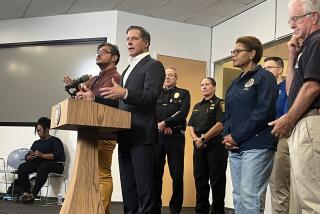This isn’t the reopened school we’d expected

- Share via
Middle and high school students in the Los Angeles Unified School District will head back to campus two days a week in late April or early May, assuming various stars align. By that time, barely any of the school year will be left to salvage — which is why state leaders should be focused on creating robust summer schools that will help students make up for lost learning.
Under L.A. Unified’s agreement with teachers, which is similar to those in other large California districts, students will still be taught remotely, but roughly half the time they’ll sit in classrooms on campus, if that makes any sense. Instead of traveling from classroom to classroom for each subject, they will stay with their advisory teacher — in the modern version of homeroom — and learn online from other teachers in other classrooms. Students at home on those days will be in the same virtual classes as those at school, both groups learning online.
The advisory teachers, meanwhile, will be teaching their usual courses too, via headsets and computers, as they keep an eye on the preteens and teens in their midst. It sounds like a difficult, distracted version of instruction.
The idea is to reduce the number of contacts with other people during the day. In addition, revamping the schedule this late in the school year to move teachers and students back to in-person classes would create too much of a logistical nightmare.
And there are a few advantages to L.A. Unified’s approach over full-time remote learning from home. Parents who have to leave home to work will know that their kids are in a safe environment during the day, with food prepared for them and reliable Wi-Fi. Students will get to socialize during lunchtime and join sports and other clubs, an important boost to their mental health. They’ll have tutors who can work with them one-on-one.
But it’s still a far cry from school as it should be. The return to campus has been delayed too long in most of California, and it now is occurring in too weak a form in many school districts to enable robust learning. Yes, it’s probably too late to do much about it, but that’s not an excuse. It’s a shameful lack of action, especially on the part of state leaders, including Gov. Gavin Newsom and the state Legislature.
They and Tony Thurmond, state superintendent of public instruction, have a chance to redeem the situation by starting right now to plan for summer school like California has never seen it before. Not recreation and “enrichment” courses that do little more than keep kids occupied, but intensive classes in core subjects — at school, taught by live teachers — that assess what every student has and hasn’t learned, and tailor instruction to bring each one as close as possible to “whole.” Unlike the typical summer session, this year’s version should blend seamlessly into the start of the next school year, which also will need to be rethought to accommodate students who are at widely disparate levels of achievement.
Some students might not need summer school at all; it’s not as though everyone fell hopelessly behind. Some are academically where they would have been in regular schools; others are ahead, thanks to parents who had the resources and knowledge to sustain their education. It’s better to use the available resources on students who need the help rather than bore those who already have learned the material.
This kind of intensive, individually tailored summer school hasn’t really been done before, and it will not be easy. But the COVID-19 pandemic has led to many remarkable and unprecedented achievements, including lightning-fast development of effective vaccines, that may have been thought impossible. Though individual school districts will need to design the specifics, an effort like this takes real leadership at the state level to create a concept, standards and funding mechanism that especially help students who have fallen the most behind.
State officials haven’t yet shown schools this kind of leadership during the pandemic. They can step forward now to inoculate students against educational failure, or they can continue to leave all the work to school districts and thus create a lost generation of young people.
More to Read
A cure for the common opinion
Get thought-provoking perspectives with our weekly newsletter.
You may occasionally receive promotional content from the Los Angeles Times.









